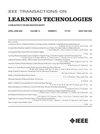探索混合式学习课程中学习者自我调节策略的表现形式
IF 2.9
3区 教育学
Q2 COMPUTER SCIENCE, INTERDISCIPLINARY APPLICATIONS
引用次数: 0
摘要
混合式学习(BL)在高等教育机构中越来越受欢迎。尽管混合式学习很受欢迎,而且从跟踪数据中检测学习策略和战术的方法也在不断进步,但人们对这些策略和战术如何应用于混合式学习环境,以及学生如何利用它们来计划、组织、监控和调节他们在混合式学习环境中的学习却知之甚少。为了填补这一空白,我们分析了 267 名学生在三门本科水平的基础教育课程中的学习策略和战略表现,这些课程具有不同的课程设计、教学活动和学习情境。我们采用了一种数据驱动的方法,结合隐马尔可夫模型来确定学生的学习策略。然后,我们采用最优匹配法,根据学生采用的策略序列以及这些策略与他们自我报告的自我调节学习(SRL)技能之间的关系来确定学生的策略。我们的研究结果表明,学生的策略和战略因课程设计和学习环境的不同而有很大差异。使用时间管理资源的策略在各门课程中都很常见。相比之下,在重温旧教材和与 SRL 支持工具互动时使用的策略则因课程而异。我们确定了与表层和深层学习相关的策略,并发现表层策略在所有课程中都有一致的表现。这些研究结果有助于更好地理解学生在基础学习环境中的学习机制,并对教学设计和自学能力支持具有重要意义。本文章由计算机程序翻译,如有差异,请以英文原文为准。
Exploring Manifestations of Learners’ Self-Regulated Tactics and Strategies Across Blended Learning Courses
Blended learning (BL) has become increasingly popular in higher education institutions. Despite its popularity and the advances in methodologies for the detection of learning tactics and strategies from trace data, little is known about how they apply to BL settings and, therefore, how students use them to plan, organize, monitor, and regulate their learning in these settings. To address this gap, we analyzed the manifestations of learning tactics and strategies of 267 students across three undergraduate-level BL courses with different course designs, instructional activities, and learning contexts. We employed a data-driven method that incorporates hidden Markov models to determine students’ learning tactics. Then, we employed optimal matching to identify the students’ strategies based on the sequences of tactics they deployed and how they relate to their self-reported self-regulated learning (SRL) skills. Our results indicate that students’ tactics and strategies varied significantly depending on the course design and learning context. Tactics with regard to the use of time management resources were common across courses. In contrast, tactics deployed when revisiting old material and interacting with an SRL support tool were course-specific. We identified strategies related to surface and deep learning and found that surface-level strategies manifested consistently across all courses. These findings contribute to a better understanding of student learning mechanisms in BL environments and have implications for instructional design and SRL support.
求助全文
通过发布文献求助,成功后即可免费获取论文全文。
去求助
来源期刊

IEEE Transactions on Learning Technologies
COMPUTER SCIENCE, INTERDISCIPLINARY APPLICATIONS-
CiteScore
7.50
自引率
5.40%
发文量
82
审稿时长
>12 weeks
期刊介绍:
The IEEE Transactions on Learning Technologies covers all advances in learning technologies and their applications, including but not limited to the following topics: innovative online learning systems; intelligent tutors; educational games; simulation systems for education and training; collaborative learning tools; learning with mobile devices; wearable devices and interfaces for learning; personalized and adaptive learning systems; tools for formative and summative assessment; tools for learning analytics and educational data mining; ontologies for learning systems; standards and web services that support learning; authoring tools for learning materials; computer support for peer tutoring; learning via computer-mediated inquiry, field, and lab work; social learning techniques; social networks and infrastructures for learning and knowledge sharing; and creation and management of learning objects.
 求助内容:
求助内容: 应助结果提醒方式:
应助结果提醒方式:


